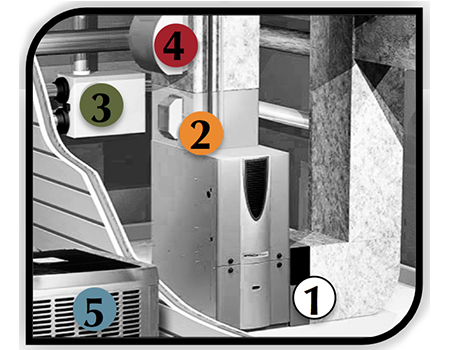
There are five major contributors to poor Indoor Air Quality: inadequate air filtration, poor air sanitation, inconsistent fresh air ventilation, air pollution from the out gassing of building materials and supplies in the form of volatile organic compounds, and the control of high humidity. Modern construction and “tight building” methods have improved energy efficiency, however have led to higher levels of indoor air pollutants. The upside to this is that Indoor Air Quality products exist; that in combination with each other can clean and refresh your indoor air without loosing efficiency.


- AIR FILTRATION: The utilization of particulate media filters are intended to improve indoor air quality by capturing and retaining large airborne particulate matter such as dust, pollen, and animal dander. Media filters that comply with the EPA airPLUS quality standard should be rated MERV 8 or higher according to ASHRAE 52.2 (at approximately 295 fpm). The system should be designed so that there are no visible bypass between the filter and the filter rack
- AIR SANITATION: The utilization of Ultraviolet Germicidal Irradiation Cleaners (UVGI) cleaners are intended to improve indoor air quality by deactivating indoor biological pollutants that are airborne or growing on the moist interiors of HVAC surfaces such as cooling coils, drain pans, or ductwork
- GENERAL VENTILATION: The utilization of a mechanical ventilation system to exchange fresh outdoor air throughout the structure, and exhaust polluted air. Mechanical ventilation systems that comply with the EPA airPLUS quality standard should meet a rated fan airflow (at 0.25 in. w.c.) or the requirements of ASHRAE 62.2 Table section 7.1, 7.3
- POLLUTION CONTROL: The utilization of a Photocatalytic Oxidation Cleaner. (PCO) cleaners are intended to destroy Volatile Organic Compounds (VOC) and odors in the air by converting them into inactive byproducts through the use of a catalyst reaction known as photocatalytic oxidation
- HUMIDITY CONTROL: The utilization of an air conditioner with a “reheat” dehumidification function or a dedicated central dehumidifier unit. Humidity control systems that comply with the EPA airPLUS quality standard should have sufficient latent capacity to maintain an indoor relative humidity (RH) at or below 60 percent
